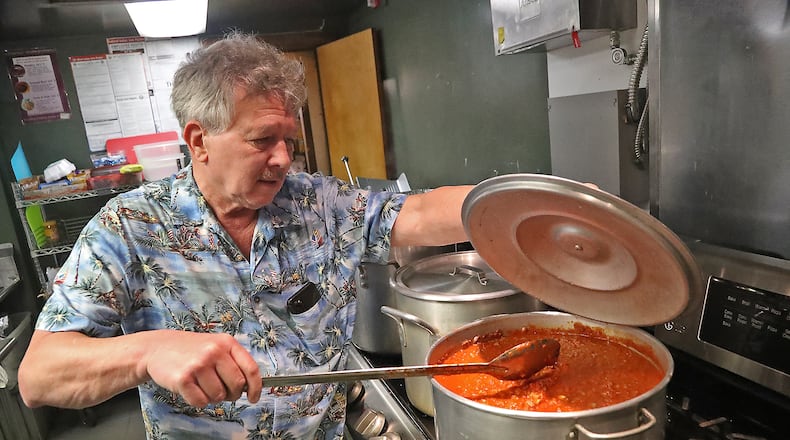“I’ve noticed (the increases) and you know we just deal with it,” said Stegner, who is the president and managing operator of the kitchen. “Everything I read is saying that it’s going to get worse.”
Last week the government said consumer prices in April jumped 8.3% from a year ago. That was below the 8.5% year-over-year surge in March, which was the highest since 1981. But it is still making it hard for millions of people to keep up with surging prices.
Despite the higher food prices and more demand, the organizations said they are optimistic they will be able to continue to serve the community.
Truesdale said the Foodbank has spent more than $1 million this fiscal year on food to supplement the products they get from other means such as donations, the collection of food people don’t buy at grocery stores and federal commodity products. Overall, the Foodbank gives out just shy of 18 million pounds of food to people and its partner agencies.
Credit: JIM NOELKER
Credit: JIM NOELKER
“We are very fortunate that our wholesale food purchase budget is relatively small (compared) to everything we receive here,” Truesdale said. “However, we know that there are challenges still to the product flow, we know there are still challenges at the end of the day in manufacturing and it’s taking items longer to get here.”
“We had a total of 14 USDA product loads canceled over the last six months so that talks a little bit too about trucker shortages, transportation challenges ... and supply chain,” she said. “That is certainly a concern. We always want to be able to buy what we need to supplement the product we have here on site.”
Truesdale said the Foodbank works hard to use money to get the most amount of food possible to help people. She said the community has stepped up to help, too. On Saturday, the Foodbank held a Stamp Out Hunger Food Drive with local postal carriers and received about 140,000 pounds of food.
Because of inflation and a reduction in aid, Second Harvest Foodbank — which serves Clark, Champaign and Logan counties — is facing challenges.
“Compared to last year at this time, we’re about 50% down in what we have received in the past in federal food donations and then about 20% down from food drives in our collection of food at the grocery stores,” Executive Director Tyra Jackson said. “All of that combined is truly having an impact on our budget because we’re needing to purchase more food outright.”
The pandemic forced roughly 60 million Americans to seek help for food insecurity, according to Feeding America. At the end of 2021, as hiring boomed, demand for food banks returned to regular levels. But the relief was short-lived.
Before the pandemic, the Dayton Foodbank saw about 120 to 150 households come through its drive-thru every two hours during distribution days. In March 2020, 750 households were coming through every two hours. Now there are about 300 households who come through.
“We’re seeing a number of individuals coming through here because they are struggling to buy the food that they need,” Truesdale said. “So it’s important to us to be able to supply additional product to these individuals, fresh produce, lean meats, dairy, eggs have even gone up. Those are all items that we want to have in stock as best as possible to provide to individuals so they can use the funds that they have to purchase other cheaper items that have not increased as drastically in cost.”
Stegner said the kitchen purchases about 90% of its food and needs to buy restaurant quantity. He said the kitchen did get some government funds to help pay for food. He said the kitchen was averaging around 200 to 250 people coming in for a meal. Last week the kitchen saw more than 300 people.
“So far we have been able to handle it,” he said. “We’ve gotten some good donations. But pretty soon, inflation will hit the people. We got more and more people coming to the soup kitchen to make ends meet.”
The Associated Press contributed to the story
About the Author


